2004 Hyundai Coupe coolant reservoir
[x] Cancel search: coolant reservoirPage 143 of 389

DO-IT-YOURSELF MAINTENANCE 6-11
G090A01A-GAT
FILLING THE WASHER RESERVOIR The washer fluid reservoir supplies fluid to the windshield washer system. A good quality washer fluid should be used to fill the washer reservoir. The fluid level should bechecked more frequently during inclementweather or whenever the washer system is inmore frequent use. The capacity of the washer reservoir is 3.0 liters (3.2 U.S. quarts). CAUTION:
o Radiator antifreeze (engine coolant) should not be used in the washer system because it will damage the car's finish.
o The washer should not be operated if the washer reservoir is empty. This can dam-age the washer fluid pump.
HGK217
G080A02A-AAT WINDSHIELD WIPER BLADES The wiper blades should be carefully inspected from time to time and cleaned to remove accu-mulations of road film or other debris. To cleanthe wiper blades and arms, use a clean spongeor cloth with a mild soap or detergent and water.If the wipers continue to streak or smear theglass, replace them with Genuine HyundaiReplacement Parts or their equivalent. CAUTION:
o Do not operate the wipers on dry glass.
This can result in more rapid wear of the wiper blades and may scratch the glass.
o Keep the blade rubber out of contact with petroleum products such as engineoil, gasoline etc.HEF119
Transaxle lubricant in the manual transaxle should
be checked at those intervals specified in the vehicle maintenance schedule in Section 5. Recommended Oil
Use only HYUNDAI GENUINE PARTS MTF
75W/90 (API GL-4) in the manual transaxle.Manual Transaxle Oil Capacity
5 speed : 2.15L (2.27 U.S. quarts) 6 speed : 2.2L (2.32 U.S. quarts) WARNING: It is always better to check the transaxle oil
level when the engine is cool or cold. If the engine is hot, you should exercise great caution to avoid burning yourself on hot engine or exhaust parts. G100A02GK-GAT
CHECKING THE TRANSAXLE OIL (MANUAL)
G110A01E
Filler plug
Drain plug
Page 152 of 389

DO-IT-YOURSELF MAINTENANCE
6-20 G260A02A-AAT
REPLACING LIGHT BULBS
Before attempting to replace a headlight bulb, be sure the switch is turned to the "OFF"position. The next paragraph shows how to reach head- light bulbs so they may be changed. Be sure toreplace the burned-out bulb with one of thesame number and wattage rating. CAUTION: Keep the lamps out of contact with petro-leum products such as oil, gasoline etc. G270A02A-GAT HEADLIGHT BULB Replacement instructions:
HGK225
1. Allow the bulb to cool. Wear eye protection.
2. Always grasp the bulb by its plastic base, avoid touching the glass.High Beam Low Beam
Turn signal Light
G240A01A-AAT POWER STEERING HOSES It is suggested that you check the power steer- ing hose connections for fluid leakage daily.The power steering hoses should be replaced ifthere is severe surface cracking, pulling, scuff-ing or worn spots. Deterioration of the hosecould cause premature failure. G250A01A-AAT
FOR MORE INFORMATION ABOUT YOUR HYUNDAI
If you desire additional information about main- taining and servicing your Hyundai, you maypurchase a factory Shop Manual at your Hyundaidealer's parts department. This is the samemanual used by dealership technicians andwhile it is highly technical it can be useful inobtaining a better understanding of your carand how it works.
G230A03A-GAT
POWER STEERING FLUID LEVEL
The power steering fluid level should be checked
regularly.
To check the power steering fluid level, be sure
the ignition is "OFF", then check to make cer-tain that the power steering fluid level is be-tween the "MAX" and "MIN" level markings onthe fluid reservoir.
NOTE: Grinding noise from the power steering
pump may be heard immediately after the engine is started in extremely cold condi-tions (below - 20°F). If the noise stops dur-
HGK214
G220C01A-AAT
Checking Condenser Cooling Fan
The condenser coolant fan should come on
automatically whenever the air conditioning is in operation. ing warm up, there is no abnormal functionin the system. It is due to a power steeringfluid characteristic in extremely cold condi-tions. Recommended Fluid Use PSF-3 type fluid NOTE: Do not start the engine when the power steering oil reservoir is empty.
Page 303 of 389
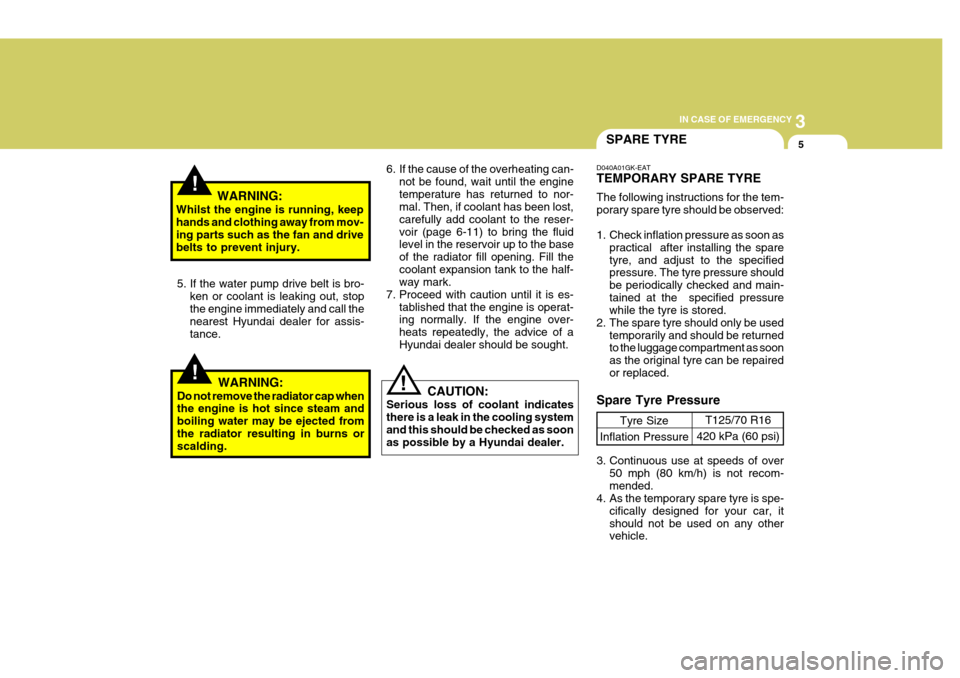
3
IN CASE OF EMERGENCY
5
!
!WARNING:
Whilst the engine is running, keep hands and clothing away from mov- ing parts such as the fan and drive belts to prevent injury.
5. If the water pump drive belt is bro- ken or coolant is leaking out, stop the engine immediately and call the nearest Hyundai dealer for assis-tance.
WARNING:
Do not remove the radiator cap when the engine is hot since steam and boiling water may be ejected fromthe radiator resulting in burns or scalding.
!
6. If the cause of the overheating can- not be found, wait until the engine temperature has returned to nor- mal. Then, if coolant has been lost, carefully add coolant to the reser-voir (page 6-11) to bring the fluid level in the reservoir up to the base of the radiator fill opening. Fill thecoolant expansion tank to the half- way mark.
7. Proceed with caution until it is es- tablished that the engine is operat-ing normally. If the engine over- heats repeatedly, the advice of aHyundai dealer should be sought.
CAUTION:
Serious loss of coolant indicatesthere is a leak in the cooling systemand this should be checked as soon as possible by a Hyundai dealer.D040A01GK-EAT TEMPORARY SPARE TYRE The following instructions for the tem- porary spare tyre should be observed:
1. Check inflation pressure as soon as practical after installing the spare tyre, and adjust to the specified pressure. The tyre pressure should be periodically checked and main-tained at the specified pressure while the tyre is stored.
2. The spare tyre should only be used temporarily and should be returnedto the luggage compartment as soon as the original tyre can be repairedor replaced.
SPARE TYRE
Tyre Size
Inflation Pressure T125/70 R16
420 kPa (60 psi)
Spare Tyre Pressure
3. Continuous use at speeds of over 50 mph (80 km/h) is not recom- mended.
4. As the temporary spare tyre is spe-
cifically designed for your car, itshould not be used on any other vehicle.
Page 324 of 389

5VEHICLE MAINTENANCE REQUIREMENTS
8
6ZF060F1-A
o Vacuum, crankcaseventilation hoses
Inspect the surface of hoses for evi- dence of heat and/or mechanical dam- age. Hard and brittle rubber, cracking, tears, cuts, abrasions, and excessiveswelling indicate deterioration. Particu- lar attention should be paid to examin- ing those hose surfaces nearest tohigh heat sources, such as the ex- haust manifold. Inspect the hose routing to assure that the hoses do not come in contact with any heat source, sharp edges or mov- ing component which might cause heatdamage or mechanical wear. Inspect all hose connections, such as clamps and couplings, to make sure they aresecure, and that no leaks are present. Hoses should be replaced immedi- ately if there is any evidence of dete-rioration or damage. 6ZF060H1-A
o Air cleaner filter
A Genuine Hyundai air cleaner filter is
recommended when the filter is re- placed.
6ZF060J1-A
o Spark plugs
Make sure to install new spark plugs
of the correct heat range.
F060N02E-EAT
o Valve Clearance
Inspect excessive valve noise and/or
engine vibration and adjust if neces- sary. A qualified technician should perform the operation. 6ZF070B1-A
o Cooling system
Check the cooling system part, such
as radiator, coolant reservoir, hosesand connections for leakage and dam- age. Replace any damaged parts.
6ZF070C1-A
o Coolant
The coolant should be changed at
the intervals specified in the mainte-nance schedule.
6ZF070D1-A
o Manual transaxle oil
Inspect the manual transaxle oil ac-
cording to the maintenance schedule. NOTE:
If the oil level is low, check for
possible leaks before adding oil. Do not overfill.
Page 328 of 389
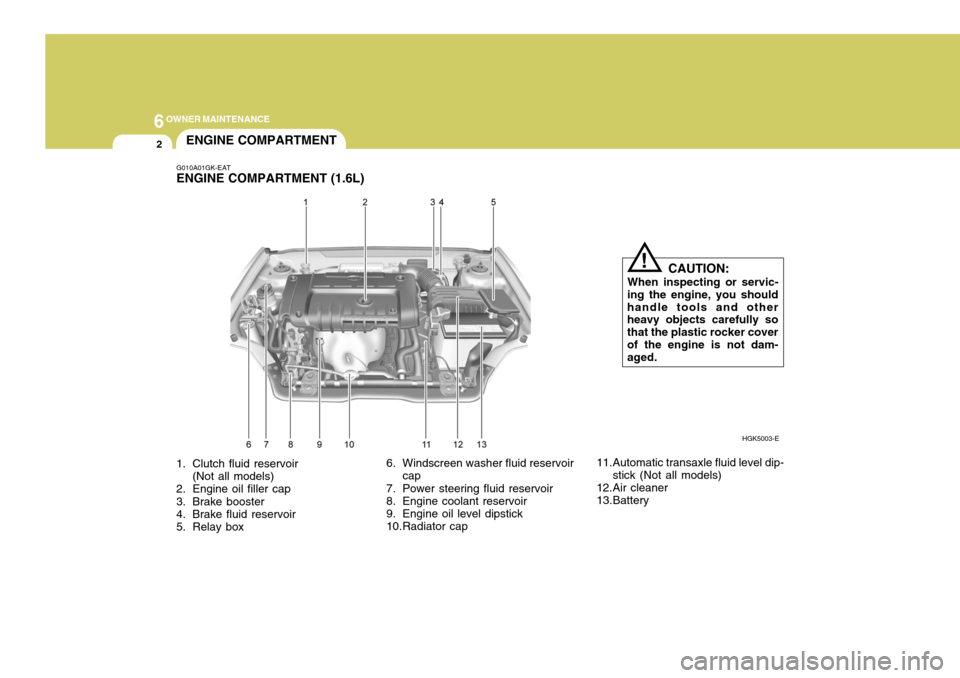
6OWNER MAINTENANCE
2
1. Clutch fluid reservoir
(Not all models)
2. Engine oil filler cap
3. Brake booster
4. Brake fluid reservoir
5. Relay box
G010A01GK-EAT ENGINE COMPARTMENT (1.6L)
ENGINE COMPARTMENT
HGK5003-E
CAUTION:
When inspecting or servic-
ing the engine, you should handle tools and other heavy objects carefully so that the plastic rocker coverof the engine is not dam- aged.
!
6. Windscreen washer fluid reservoir cap
7. Power steering fluid reservoir
8. Engine coolant reservoir
9. Engine oil level dipstick
10.Radiator cap 11.Automatic transaxle fluid level dip-
stick (Not all models)
12.Air cleaner
13.Battery
Page 329 of 389
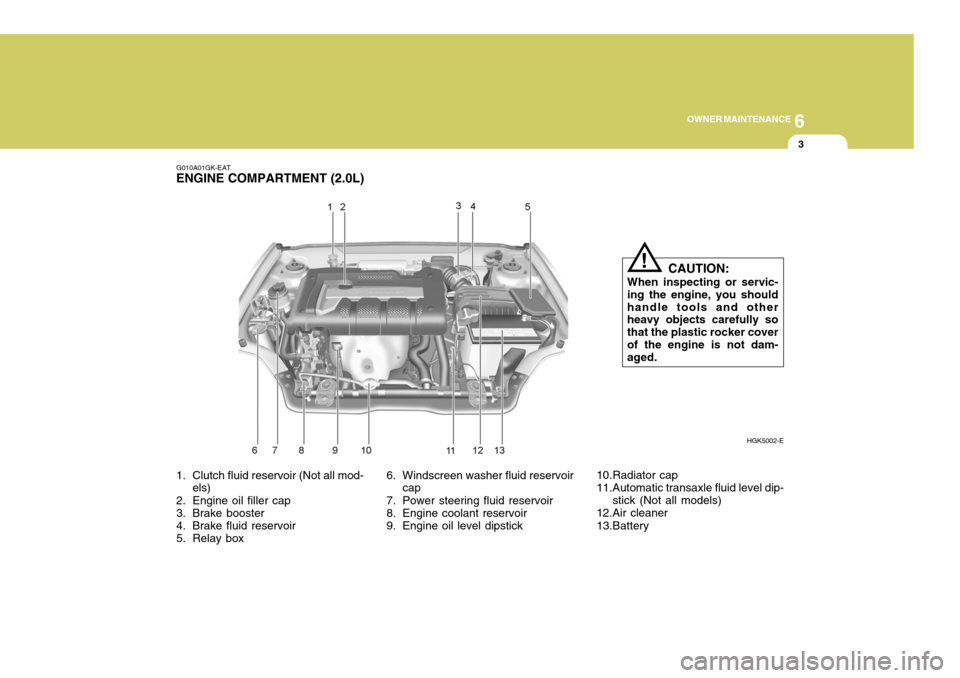
6
OWNER MAINTENANCE
3
G010A01GK-EAT
ENGINE COMPARTMENT (2.0L)
1. Clutch fluid reservoir (Not all mod- els)
2. Engine oil filler cap
3. Brake booster
4. Brake fluid reservoir
5. Relay box 6. Windscreen washer fluid reservoir
cap
7. Power steering fluid reservoir
8. Engine coolant reservoir
9. Engine oil level dipstick 10.Radiator cap
11.Automatic transaxle fluid level dip-
stick (Not all models)
12.Air cleaner
13.Battery CAUTION:
When inspecting or servic- ing the engine, you shouldhandle tools and other heavy objects carefully so that the plastic rocker coverof the engine is not dam- aged.
!
HGK5002-E
Page 330 of 389
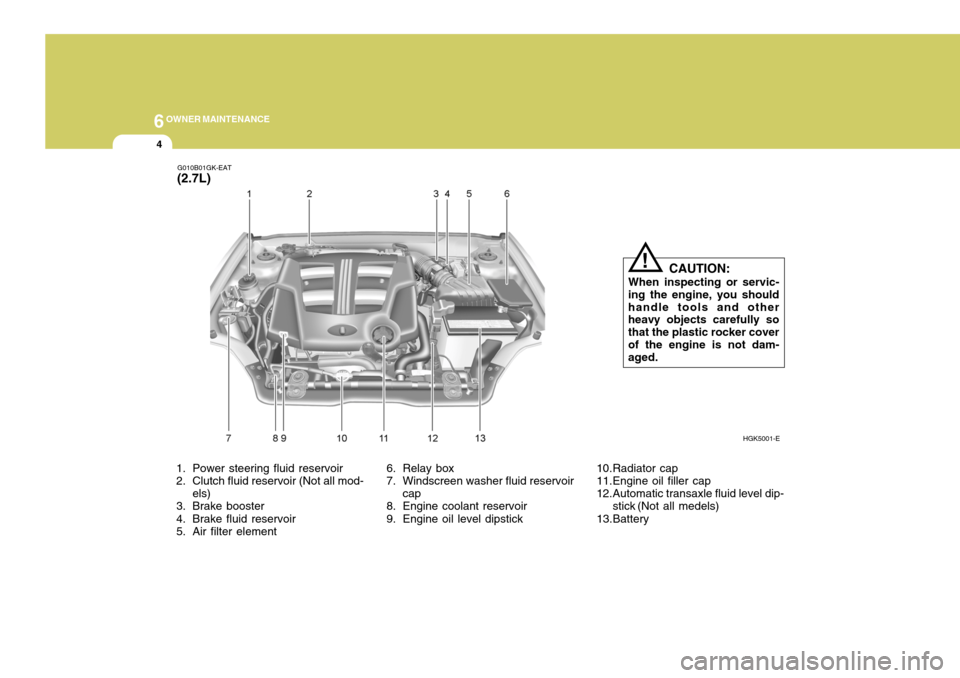
6OWNER MAINTENANCE
4
1. Power steering fluid reservoir
2. Clutch fluid reservoir (Not all mod-els)
3. Brake booster
4. Brake fluid reservoir
5. Air filter element 6. Relay box
7. Windscreen washer fluid reservoir
cap
8. Engine coolant reservoir
9. Engine oil level dipstick 10.Radiator cap
11.Engine oil filler cap
12.Automatic transaxle fluid level dip-
stick (Not all medels)
13.Battery
G010B01GK-EAT
(2.7L)
HGK5001-E
CAUTION:
When inspecting or servic-ing the engine, you shouldhandle tools and other heavy objects carefully so that the plastic rocker coverof the engine is not dam- aged.
!
Page 337 of 389
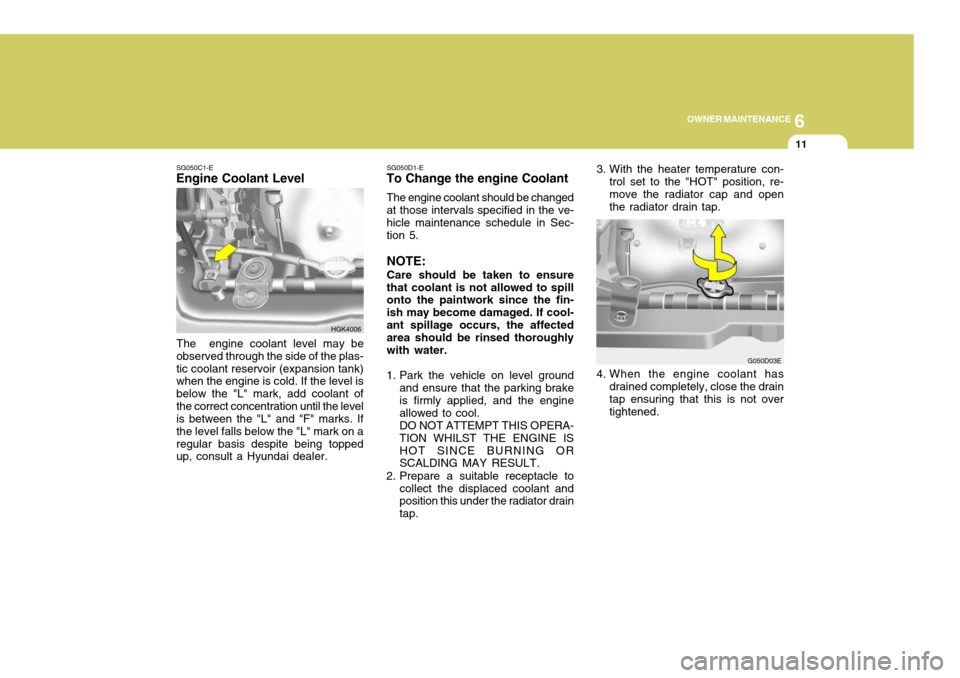
6
OWNER MAINTENANCE
11
HGK4006
SG050C1-E
Engine Coolant Level
The engine coolant level may be
observed through the side of the plas- tic coolant reservoir (expansion tank) when the engine is cold. If the level is below the "L" mark, add coolant ofthe correct concentration until the level is between the "L" and "F" marks. If the level falls below the "L" mark on aregular basis despite being topped up, consult a Hyundai dealer. SG050D1-E
To Change the engine Coolant
The engine coolant should be changed at those intervals specified in the ve- hicle maintenance schedule in Sec- tion 5. NOTE: Care should be taken to ensure that coolant is not allowed to spill onto the paintwork since the fin- ish may become damaged. If cool-ant spillage occurs, the affected area should be rinsed thoroughly with water.
1. Park the vehicle on level ground and ensure that the parking brake is firmly applied, and the engine allowed to cool.DO NOT ATTEMPT THIS OPERA-TION WHILST THE ENGINE ISHOT SINCE BURNING OR SCALDING MAY RESULT.
2. Prepare a suitable receptacle to collect the displaced coolant andposition this under the radiator drain tap. 4. When the engine coolant has
drained completely, close the drain tap ensuring that this is not over tightened. G050D03E
3. With the heater temperature con-
trol set to the "HOT" position, re-move the radiator cap and open the radiator drain tap.